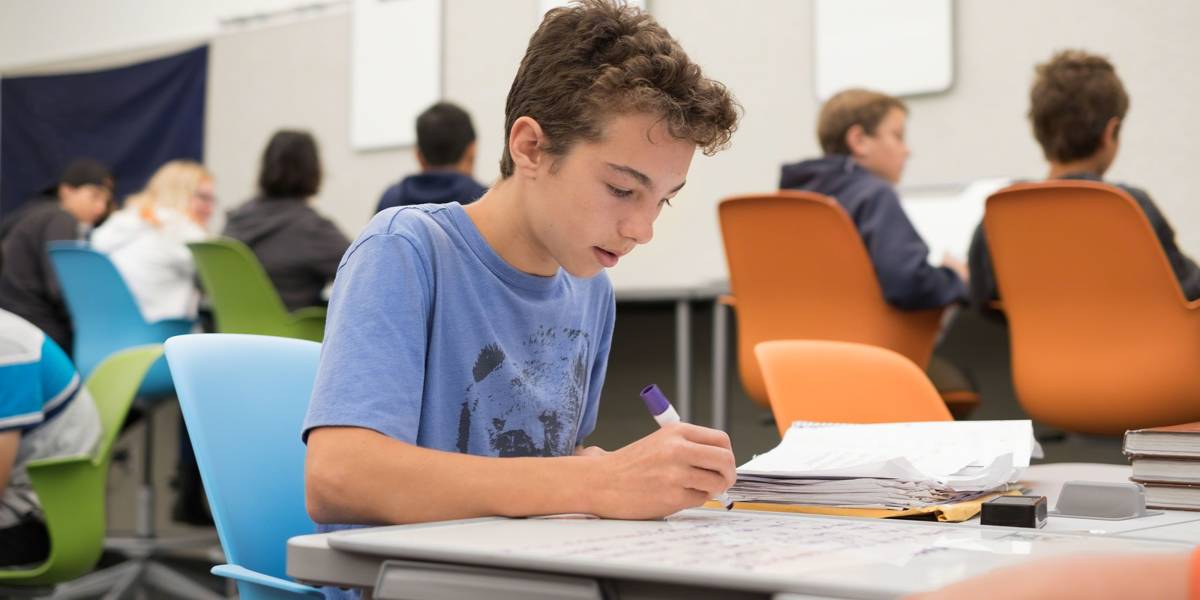Quality education has always been one of the most important priorities of different countries and governments worldwide. The methods and approaches used varied from one country to another and from one educational institution to another, with the aim of developing the educational process as each country sought to provide the best possible educational experience for students. As students become the center of the educational process, many new challenges emerge, some of which may require new institutional strategies. Exploring students’ ways of thinking, abilities, habits, self-concepts, psychological and social needs, and academic backgrounds is very essential to ensuring the success of the educational process.
Among the terms that have recently appeared in the dictionary of the educational process is what is known as “active learning.” Whether you are a primary school student or a university student, a school teacher or a university professor, you must have heard about the term “active learning” and how it has become very prevalent in many educational institutions around the world. What is meant by “active learning”? What are its benefits, and what is the difference between it and passive learning? And most importantly, how do you become an active learner?
What is meant by “active learning”?
Active learning is a method of learning that involves actively engaging students in the course of study through discussions, problem solving, case studies, role plays, and other methods. Active learning methods require students to participate in the learning process through thinking, discussion, investigation, and creativity.
For example, in class, students apply the skills they have learned practically, solve problems, attempt to answer complex questions, make decisions, propose solutions, and explain ideas either through writing or discussion. critical to the success of the active learning process.
In other words, active learning approaches place a greater degree of responsibility on the learner and give less importance to passive methods such as lectures and books. However, teacher guidance remains a critical and important factor in active learning classes. Numerous educational studies have shown that incorporating active learning strategies into undergraduate courses significantly enhances students’ learning experiences. Active learning activities may last as long as two minutes and may cover the entire lecture period.
Passive vs active learning
It is well understood that learning is a continuous process based on bringing about fundamental changes in the learner’s behavior as a result of direct or indirect experiences.However, learning does not necessarily imply improving or developing an individual in the right direction. During the passive learning experience, the student has to wait to get the guidance, instructions, or information provided by the teacher, whereas in the active learning process, the students look for different ways to increase their participation in the learning process. In other words, in passive learning methods, instructions are provided to the student who implements them, whether they are written or spoken. During active learning, the student is fully involved in the learning process, which is the most important component of this process.
It is worth noting that passive learning is not only limited to schools and universities but is also part of everyday life. The books we read, the TV shows we watch, and the social media we follow are all forms of passive learning. In the same way, through passive learning, we absorb behaviors from our parents that are automatically passed on to our children.
Here are some points that detail the difference between active and passive learning:
1- The role of the learner in the process
Active learning is the direct and effective involvement of learners in the learning process. Passive learning, on the other hand, occurs when the teacher provides all of the information to the students and all they have to do is absorb it.
Whereas passive learning is teacher-centered, active learning is student-centered, in which the focus is shifted from the provision of information by the teacher to the active participation of the student.
2- The role of the teacher in the process
In active learning, the teacher plays the role of a catalyst who creates a conducive environment for the student to acquire knowledge, but in passive learning, the teacher is seen as the primary source of knowledge.
The methods used in the learning process
When it comes to student participation, active learning tends to use methods where students learn the concept by doing, which is why students need to be actively involved in the learning process. In the case of passive learning methods, traditional learning methods are used, where the learner’s participation is relatively low.
3- The skills that are being developed
- Active learning techniques help develop higher-order thinking skills (HOTS), which may include analysis, synthesis, evaluation, public speaking, and collaboration. In contrast, passive learning often develops lower-order thinking skills (LOTS) in students, which may include identifying, describing, and writing skills.
- Not only that, active learning gives students the opportunity to challenge and change preconceived notions and biases during their discussions and defend their ideas, which contributes to providing students with strong observational, communication, and critical thinking skills. On the other hand, with passive learning, students have the opportunity to think of their ideas as nothing more than those of a listener, i.e., they may not always have the opportunity to confront an idea, but they can still recognize the difference between what they believe in and what is presented.
- Active learning promotes divergent thinking among students, which leads to the generation of creative or unique ideas. In contrast, passive learning promotes convergent thinking, meaning students will be able to provide the correct answer to a clear question without having any creative side at all.
4- Retaining and remembering information
When students learn the concept by performing the activity themselves, they will understand it better, and thus the rate of retention of information will be greater in the case of active learning. On the contrary, the rate of information retention is relatively low in the case of passive learning, as students depend on their teachers to provide information.
5- The source of knowledge
In active learning, the main source of knowledge is practical observation, practical application, experiments, etc., while in passive learning, the main source of knowledge is the teacher, trainer, books, or online resources.
The benefits of active learning
You may have noticed, through the paradox between active learning and its opposite, that the former has many benefits and positives, which we can summarize as follows:
1- Leads to higher engagement between students and teachers
There is no doubt that active learning engages students in doing things and thinking about the things they do, thus moving learners from mere observation to actively engaging in new information presented to them. When learners are directly involved in their learning material, it allows them to gain a deeper understanding and stronger connection to the material, which helps improve the learning process.

2- Improve collaboration skills
Another benefit of active learning is that it helps improve students’ collaboration skills. Rather than simply listening to the teacher’s instructions, active learning uses the power of collaboration and social interaction to learn and solve problems.
Through interactive activities, you will be able to provide students with all the necessary collaboration skills they need to make any teamwork a success.
3- It builds self-confidence.
Active learning creates an environment where learners are pushed out of their comfort zone and encouraged to share their ideas, opinions, and conclusions on certain topics rather than simply imparting knowledge. As they become more comfortable with speaking, learners will gain greater freedom and capacity for self-expression, and thus their self-confidence will increase.
Confidence in action is certainly one of the most important benefits of active learning, which gives students the ability to do more of their tasks quickly, effectively, and at a high level of quality.
4: It enhances information retention.
Confucius says: “Tell me, and I will forget… Show me, and I may remember… Involve me, and I will understand”!
And this is exactly what active learning does. It has been scientifically proven that interactive (or active) learning leads to a significant increase in the ability to retain information. In fact, many studies have demonstrated that learners absorb more information through “action learning” due to its direct and purposeful nature, which contrasts with the traditional pattern of one-sided learning.
Because learners are given the opportunity to actively participate and do things, they retain at least 90% of the information they are given.
5: It makes learning more fun and exciting.
Nothing is more boring than just sitting and listening to a training or lecture until the conversation is over. Lack of interaction leads to a poor learning experience, which means an absolute waste of time and energy. Another benefit of active learning is that it is generally more fun and exciting because everyone is expected to participate, play a role in activities and discussions, and apply their knowledge in practice.
6- It increases learners’ motivation to learn.
In an active learning environment, no one is invisible, and there is no preference for one student over another. As indicated in the previous sections, this type of learning requires the presence and cooperation of everyone for a productive discussion. By adopting this behavior, all students will begin to feel important and begin to gain motivation to learn over time.
7- It increases creativity and innovation.
Another great benefit of active learning is that it increases student creativity and innovation. As it is entirely dependent on the students, they are pushed to use their imagination and extend their creativity to make an excellent contribution to the class.
Active learning also helps broaden students’ perspectives by having them confront each other with their different ideas as they work in groups. Collaborating and being involved in such a collaborative environment will allow you to see new possibilities, create new knowledge, and come up with more creative ideas.
8- Improves critical thinking and problem solving skills
Active learning activities such as question-and-answer sessions and discussions encourage outside-the-box thinking and take students’ critical thinking to the next level. These activities not only help to increase understanding of the topics but also develop students’ problem-solving and decision making abilities.
Students will also learn how to construct stronger arguments to defend their points of view, challenge the views of others, and recognize logical fallacies. There is no doubt that acquiring such skills will enable them to make better and more rational decisions at work, as well as to devise innovative strategies and solutions to face any challenges.
9- Allows immediate evaluation from teachers and colleagues
Active learning usually entails hands-on activities, quizzes, and assessments that allow trainers to instantly assess learners’ understanding of their training topics, giving them the ability to provide learners with immediate instructions and guidance to overcome any performance gaps and achieve the intended learning objective. Learners can also provide feedback about the learning process and express any concerns they may have about the learning experience.

10- It increases the success of the academic courses.
Even if a lecture or course features the best education technology training tools and materials, training will fail if learners are not fully engaged or motivated to learn. And here comes the role of active learning to overcome all these obstacles that prevent the success of training. Active learners work hard to succeed and achieve better results because they take an active part in their learning environments.
Without forgetting that active learning in general is more fun and exciting because it goes beyond just reading and listening, everyone is expected to participate and do something, either individually or collectively, which in turn allows for increased productivity and increased participation in and completion of training.
Read also: Profit sites from self employment



